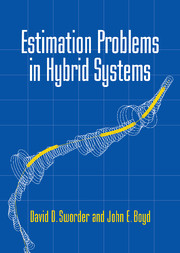Book contents
- Frontmatter
- Contents
- List of Illustrations
- Preface
- 1 Hybrid Estimation
- 2 The Polymorphic Estimator
- 3 Situation Assessment
- 4 Image-Enhanced Target Tracking
- 5 Hybrid Plants with Base-State Discontinuities
- 6 Mode-Dependent Observations
- 7 Control of Hybrid Systems
- 8 Target Recognition and Prediction
- 9 Hybrid Estimation Using Measure Changes
- Appendix 1 PME Derivation Details
- Appendix 2 COM Derivation Details
- Bibliography
- Index
- Glossary
9 - Hybrid Estimation Using Measure Changes
Published online by Cambridge University Press: 17 August 2009
- Frontmatter
- Contents
- List of Illustrations
- Preface
- 1 Hybrid Estimation
- 2 The Polymorphic Estimator
- 3 Situation Assessment
- 4 Image-Enhanced Target Tracking
- 5 Hybrid Plants with Base-State Discontinuities
- 6 Mode-Dependent Observations
- 7 Control of Hybrid Systems
- 8 Target Recognition and Prediction
- 9 Hybrid Estimation Using Measure Changes
- Appendix 1 PME Derivation Details
- Appendix 2 COM Derivation Details
- Bibliography
- Index
- Glossary
Summary
Change of Measure
In earlier chapters of this book, we studied state estimation and regulation with an emphasis on time-continuous hybrid plants with a mix of time-continuous and time-discrete observations. The plant input/state-output representation is such that each state category is associated with an observation process and filtration: {yt} and {Yt} for the base-state, and {zt} and {t} for the modal-state. Low level data fusion generates the filtration Gt = Yt∨ t. An engineer seeks practical algorithms for approximating the Gt-regime probabilities along with those Gt-moments (including cross moments) important in the application. The primary tool in those chapters was the polymorphic estimator in its sundry realizations. The PME generates serviceable approximations to relevant Gt-conditional moments. Although t is the vector of conditional regime probabilities, the PME does not provide the Gt-distribution function of the zygostate.
The PME is premised on the assumption that the modal measurement is a good one; at least {zt} is the best measurement available as regards the regime. The modal measurement is not perfect to be sure, but it is good enough that base-state × modal-state cross moments depend incrementally upon {zt} alone. This hierarchical processing structure has its rationale in the way in which the engineer assembles the sensor suite. For example, the initial design of the panel temperature regulator for the solar central receiver (see Chapter 5) did not include insolation sensors.
- Type
- Chapter
- Information
- Estimation Problems in Hybrid Systems , pp. 197 - 220Publisher: Cambridge University PressPrint publication year: 1999
- 7
- Cited by

